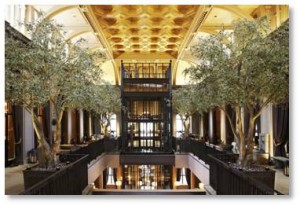This is the seventh in a series of posts on largely unknown spaces in Boston that are open to the public.
It’s not unusual for buildings of architectural and historical note to be re-purposed over time. A structure might be “upgraded” and renovated—but often not for the better. Sometimes the results are ugly but temporary. If we’re lucky, the changes aren’t structural, don’t destroy the style or craftsmanship, and can be reversed at a later date. If we’re really lucky, that renaissance actually happens.
The Back Bay’s Second Building
The good news is that it happened in the case of the original New England Museum of Natural History. Designed by William Gibbons Preston in the French Academic style, the redbrick and brownstone museum was constructed from 1863 to 1865.
It was the second building to go up in Boston’s “new land” in the Back Bay and it occupies a manicured space at 234 Berkeley Street that is a city jewel in its own right.
Romanesque arches and graceful Corinthian pilasters highlight the exterior. The museum’s interior centerpiece was originally a large, two-story hall and atrium that reached up to the ceiling, lit by clerestory windows. In this space hung the skeleton of a whale and below it were the glass-topped display cases typical of museum exhibits in the nineteenth century.
The Retail Years
The New England Museum moved out in 1951 when it expanded and became the Boston Museum of Science, now located next to the old locks on the Charles River Dam. The original building was re-purposed as the home of high-end clothing retailers Bonwit Teller (1947-1989) and men’s clothier LouisBoston (20 years). The latter store moved to the Seaport District in 2010 and closed its doors in July of this year.
During the Retail Years, the 44,000-square-foot space was modernized and renovated in ways that either blocked or disguised William G. Preston’s original design. Modern Bostonians came to know this look, which obscured the original interior.
The retail stores inhabited the space but they didn’t acknowledge it. False ceilings, false walls, partitions, divisions, dressing rooms and other devices covered up the beautiful architecture. Mezzanine levels broke up the stately atrium. The retail stores were businesses, not public institutions. They highlighted fashion over art and put clothing ahead of structure and that’s only to be expected. But over time people forgot what the original interior looked like because most of us had never seen it.
Good News for the New England Museum
Now for the good news. The latest owner is also a retailer. Restoration Hardware—now RH Boston—that sells furniture and home goods from the old New England Museum building. They took a completely different approach, however, doing their very best to return to Mr. Preston’s original design. it’s less a retail renovation than a museum restoration.
First, the AD100 firm Backen, Gillam & Kroeger Architects essentially gutted the building, removing all the newer additions and divisions and stripping it back to the walls. They consulted the original architectural drawings and old photographs. Then they boldly went where no retailer had gone before to:
- Remove the mezzanines, dividing walls, and other interior structures.
- Open the atrium from the ground floor all the way to the iridescent gilded and coffered ceiling
- Remove an elevator bank that blocked the building’s central axis
- Open up the winding staircase that was hidden behind walls
- Refurbish the original elegant details and ornamentation
- Install a glass elevator that rises 70 feet to give a bird’s eye view of the structure
To grasp the scope of this painstaking 15-month renovation, watch RH Boston’s video, with statements Gary Friedman, RH Boston’s Chairman and CEO Emeritus, from James Gillam of Backen, Gillam & Kroeger; and from William Young, Senior Preservation Planner for the Back Bay Architectural Commission.
Take a Look at the Museum Restoration
For views of the RH Boston galleries, scroll through this Architectural Digest slide show.
Don’t stop there, though. To really appreciate what RH Boston has done for the building—and for the city—stop in to see the galleries for yourself.
- Ride the glass elevator, which is a recreation of an 1892 traction-and-counterweight elevator inspired by the one in L.A.’s Bradbury Building.
- Stroll through the 18-foot antique mirrored archways on the second floor and under the 12 sparkling crystal chandeliers.
- Have a beer at the beer bar or a verre du vin at the wine bar.
- Don’t forget to wind your way down to the basement, which houses the RH Baby and Child gallery.
RH used to be called Restoration Hardware. Renamed, it now displays a different class of merchandise in what it calls its galleries and prefers to open them in historical buildings. I’m thankful that they chose William G. Preston’s New England Museum in the Back Bay and have done such a marvelous job of restoration. They have returned this architectural gem to its original shine.
Now it’s hidden only from people who knew it during the Retail Years and haven’t stopped in since. The change is amazing.
Information and Directions to the
New England Museum Restoration
#RHBoston is located at 234 Berkeley Street between Boylston and Newbury streets. It costs nothing to enter—although purchasing some of the furniture might set you back a few dollars.
It’s open during store hours:
- Sunday: 12pm – 6pm,
- Monday through Friday: 10am – 7pm
- Saturday: 10am – 7pm
Phone: 857-239-7202
Email: boston@restorationhardware.com





Listen to an interview of Smee with WBUR’s Radio Boston host Adam Ragusea, including a discussion of the Davis Museum’s Peres Maldonado Ex-voto and other works in collections throughout New England.